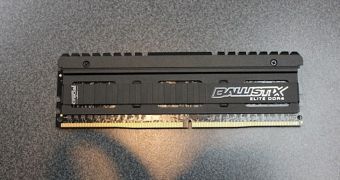Crucial seems to have one of the more ambitious collections of DDR4 products at the Computex trade show, taking place in Taipei, Taiwan. Even though availability for such things is still pegged for no sooner than 2015.
The company has brought several modules to its booth, with capacities of 4 GB, 8 GB and 16 GB, and frequencies of 2133 MHz and up. What's remarkable here is the capacity. Other DDR4 RAM memory suppliers only went for 4 GB and 8 GB modules.
Kits could reach 16 GB, sure enough, but only if you were to combine more than one slot in dual-channel or quad-channel configuration.
That's one of the assets of DDR4 memory: the ability to be set up in quad-channel collaboration. There are some DDR3 kits that can do this, and some motherboards with support for them, but they're very few.
It's kind of why DDR4 will debut on the high-end server and workstation markets before they even make the first steps on the consumer front.
It's not like the clocks of 2133 MHz and above will be of much use anywhere else before then. Except maybe on the enthusiast gaming and overclocking front, but that's a very small part of the PC market.
Back to Crucial's Ballistix Elite DDR4. The RAM looks a lot less fancy than what will become its direct competitors, like the Corsair Dominator Platinum and Value Select DDR4, or the airplane-shaped ADATA XPG Gaming DDR4.
The Ballistix Elite have understated, black heatspreaders (made of aluminum) that don't go that much higher than the module itself. Speaking of which, the memory comes in a black PCB, just like the heatsink. Clearly, associating the color black with hardcore hardware isn't a theme that will grow old any time soon.
Crucial used DRAM chips from a certain mega-fab that Micron owns in Boise, Idaho, US. Unfortunately, this is where our river of information tapers off and dries. DDR4 technology is still very much in its infancy, and companies are more concerned with proving they can provide it, rather than convince potential customers to buy their modules.
There's not going to be a lot of chance for competition when everyone is just starting out, testing the waters as it were. Well, some may argue that it's already happening, otherwise there wouldn't be fancy heatspreader designs. Ultimately, though, capacity, performance and voltages (1.2V or so) are the same across the board.

 14 DAY TRIAL //
14 DAY TRIAL //